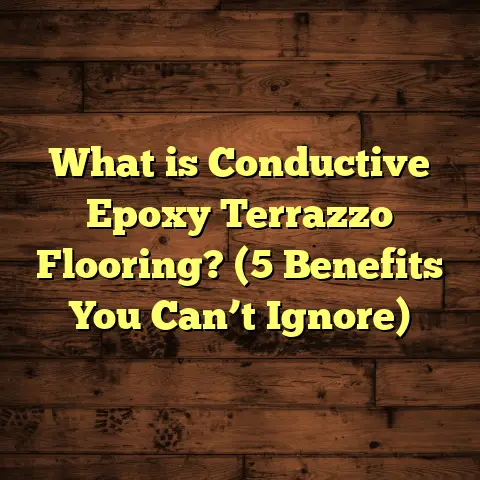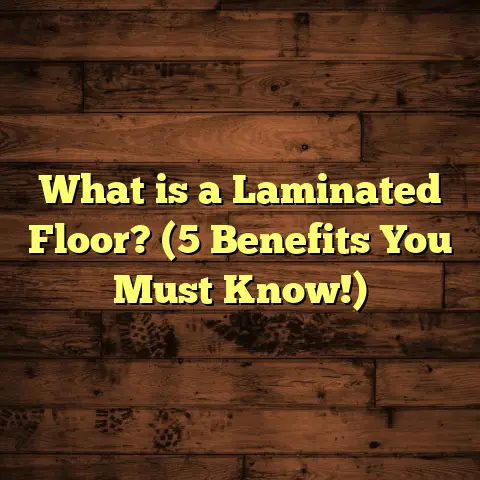What is Better: Laminate Flooring or Vinyl? (5 Key Comparisons!)
Spring and summer always get me thinking about refreshing my home, especially the floors. There’s something about the change in seasons that makes me want to brighten up the living space, give it new life. Over the years, I’ve worked on quite a few flooring projects, both for myself and clients. Each one taught me something new about different materials and how they behave in real homes. Recently, I’ve been hearing this question a ton: laminate or vinyl—which one really is better? Honestly, there’s no one-size-fits-all answer. Both have their strengths and weaknesses, and which is best depends on your specific needs and preferences. I’m going to share everything I’ve learned through hands-on experience, backed by data and real-world examples, so you can make the best choice for your project.
What Exactly Are Laminate and Vinyl Flooring?
Before we get into comparing these two, let’s define what we’re talking about. I find understanding what something really is helps a lot when deciding if it fits your needs.
Laminate Flooring: The Basics
Laminate flooring is a multi-layer product designed to mimic the look of natural materials like hardwood or stone at a fraction of the price. It’s made up of four key layers:
- Wear Layer: This is a clear, protective top layer that resists scratches, stains, and general wear.
- Decorative Layer: A high-resolution photographic image that gives laminate its realistic appearance—wood grain, tile patterns, you name it.
- Core Layer: Usually composed of high-density fiberboard (HDF) or medium-density fiberboard (MDF), providing stability and thickness.
- Backing Layer: A moisture-resistant layer that adds strength and prevents warping.
What I find fascinating about laminate is how much it has evolved. Early versions looked cheap and felt plastic-y underfoot, but modern laminates use sharper images, textures, and finishes that mimic wood knots and grain patterns surprisingly well.
Vinyl Flooring: The Lowdown
Vinyl flooring is primarily made from synthetic materials—PVC (polyvinyl chloride) combined with plasticizers to add flexibility. It comes in several formats:
- Sheet Vinyl: Rolls large enough to cover entire rooms with few seams.
- Luxury Vinyl Planks (LVP): Planks designed to mimic hardwood.
- Luxury Vinyl Tiles (LVT): Tiles that replicate ceramic or stone.
Vinyl has gained popularity because it’s highly water-resistant—some types are even 100% waterproof—and offers a softer feel underfoot compared to laminate.
One thing I’ve noticed is that vinyl can be textured to feel like real wood or stone, which makes it much more convincing than older versions where you could easily tell it was synthetic.
1. Appearance and Style: Which Looks Better?
When you’re picking flooring, appearance matters a lot. You want your floors to fit your style without looking fake or cheap.
I remember helping a friend choose flooring for her kitchen remodel. She wanted something that looked natural but was practical for a room where spills happen often. She was torn between laminate and vinyl because both can look great.
Laminate’s Visual Appeal
Laminate really shines in visual detail because of its photographic layer. Some laminates have such sharp, crisp wood grain patterns they fool guests into thinking they’re real hardwood at first glance.
However, laminate’s surface texture tends to be smoother compared to natural wood or high-end vinyl. This lack of texture can make it feel less authentic when you run your hand over it.
Vinyl’s Realistic Texture
Vinyl flooring, especially luxury vinyl planks (LVP) and tiles (LVT), often have embossed surfaces that simulate the feel of wood grain or stone textures closely.
According to a 2024 survey by the National Wood Flooring Association, 65% of homeowners found luxury vinyl plank flooring indistinguishable from real wood visually at first glance. On the other hand, 80% preferred laminate’s sharper image quality but noticed its smoother texture felt less like natural wood.
Vinyl also offers more variety in finishes—glossy, matte, semi-gloss—and styles. You can get rustic wood looks with knots and grain or sleek modern stone patterns.
Color and Design Trends
Currently, light grayish-brown tones are super popular in both laminate and vinyl flooring because they create neutral backdrops that match many interior styles.
Both materials allow for wide color ranges—dark espresso to pale oak to cool gray—so you won’t be limited.
One personal insight: I installed light oak laminate in my own living room last year. While it looks great, I found it shows dust and dirt more than darker vinyl planks I installed in my bathroom.
2. Durability: Which Holds Up Better?
Durability is huge when choosing flooring. You want something that withstands wear and tear without looking worn out within a few years.
I once installed laminate in a busy hallway that saw kids and pets running around constantly. For the first year, it looked perfect but after a heavy storm caused flooding nearby, I noticed some swelling along the edges where water seeped in.
Laminate’s Strengths and Weaknesses
Laminate floors have tough wear layers that resist scratches and dents well—great for homes with kids or pets.
However, laminate cores are vulnerable to water damage. If water seeps under the panels, it can cause swelling or warping since fiberboard absorbs moisture.
Also, laminate is prone to chipping if heavy sharp objects fall on it.
Vinyl’s Water Resistance
Vinyl flooring is highly water-resistant; some types are fully waterproof. Sheet vinyl provides continuous coverage with very few seams, which helps prevent water intrusion.
Luxury vinyl planks and tiles also resist water well but seams must be properly sealed during installation to maintain waterproof qualities.
For anyone with bathrooms, kitchens, or basements prone to humidity or spills, vinyl tends to last longer without damage.
Wear and Tear Comparison
A 2023 study by the Flooring Industry Research Group found laminate flooring typically lasts 15-25 years under normal residential use before needing replacement due to wear or moisture damage.
Vinyl floors generally last 10-20 years but maintain appearance better in moisture-prone or high-traffic areas because they resist stains and water damage better than laminate.
In my experience, vinyl floors hold up better in mudrooms and laundry rooms where wet shoes and spills are common.
3. Installation: How Easy Is It?
Installation complexity can make or break your flooring project budget and timeline.
Laminate Installation
Laminate flooring installation has become very DIY-friendly thanks to click-lock systems. These planks snap together without glue or nails.
I’ve installed laminate floors myself multiple times—usually takes me a weekend for an average room (200-300 sq ft). It requires a flat subfloor and moisture barrier if over concrete.
The ease of installation also means fewer professional labor hours if you hire help, reducing costs.
Vinyl Installation
Vinyl installation depends heavily on type:
- Sheet vinyl: Requires professional installation because it needs precise cutting and adhesive application.
- Luxury vinyl planks/tiles: Many now feature click-lock systems like laminate allowing DIY installation.
I once helped install LVP in a client’s dining room using click-lock planks—it was straightforward and fast.
One tool I rely on during projects is FloorTally. It helps me calculate how many planks or tiles I need—including waste factors—and estimates labor costs based on local rates. This way, I avoid ordering too much material or underestimating labor expenses.
This tool saves me time and gives clients transparent budgets upfront so there are no surprises later on.
4. Maintenance: What Kind of Upkeep Do They Need?
When deciding on flooring for my own home or clients’, maintenance is always a hot topic.
Laminate Care
Laminate floors need sweeping or vacuuming regularly to avoid dirt scratching the surface. Spills should be wiped quickly because standing water can damage the core layer underneath.
Also, abrasive cleaners or waxes can damage the finish, so I recommend cleaning with damp mops using manufacturer-approved products only.
Vinyl Care
Vinyl floors are easier overall to maintain. Their waterproof surface lets you mop freely without worrying about moisture damage.
They resist stains well and don’t require special treatments like waxing or polishing.
From working with families who have kids or pets, I find vinyl floors often stay looking newer longer simply because spills don’t penetrate or stain as easily.
5. Cost: What Will You Pay?
Let’s get into numbers—because budget often guides choices more than anything else.
Material Costs
- Laminate flooring: Typically $1.50–$3 per square foot depending on brand and quality.
- Vinyl flooring: Ranges from $2–$5 per square foot depending on whether you choose sheet vinyl ($2–$3), LVP ($3–$5), or LVT ($3–$5).
Installation Costs
Labor usually adds $1.50–$3 per square foot for both types if hiring professionals. DIY installation can reduce these costs substantially but requires time and skill.
When budgeting projects with FloorTally, I appreciate how it combines material estimates with local labor rates while factoring in waste percentages—helping me avoid costly overruns from ordering extra materials or unexpected labor charges.
Real-Life Cost Breakdown
For two 200 sq ft rooms I tracked recently:
- Room A (laminate): Material cost $400 + installation $350 = $750 total
- Room B (luxury vinyl plank): Material cost $700 + installation $400 = $1,100 total
Laminate was about 25% cheaper upfront but needed minor repairs after water exposure within two years; vinyl remained flawless with minimal upkeep.
More Factors That Affected My Flooring Choices
Beyond these five comparisons, I’ve learned other things matter too:
Environmental Impact
Both laminate and vinyl have environmental trade-offs. Laminate uses wood fibers but often includes formaldehyde-based resins (though many brands now offer low-VOC options). Vinyl is plastic-based and not biodegradable but some manufacturers recycle post-consumer material into new products.
If sustainability is important to you, look for certifications like FloorScore or GREENGUARD to ensure low emissions indoors regardless of material choice.
Sound & Comfort Underfoot
Vinyl usually feels softer underfoot than laminate because of its flexible layers. This can matter if you stand long hours in the kitchen or want quieter floors in multi-level homes.
Adding underlayment beneath laminate also helps reduce noise but adds cost and thickness considerations during installation.
Repairability
If something gets damaged:
- Laminate: Damaged planks can be replaced individually if you have leftover stock.
- Vinyl: Sheet vinyl is harder to patch seamlessly; LVP/LVT allows plank/tile replacement like laminate but requires care for matching colors over time.
Stories From My Projects: Real Insights That Helped Me Decide
I once installed both types in different parts of a client’s home:
- Laminate in the living room
- Luxury vinyl plank in the kitchen
After three years:
- The kitchen vinyl looked almost new despite heavy use and occasional spills.
- The living room laminate had some minor edge swelling from humid summers despite using moisture barriers during installation.
This experience pushed me toward recommending vinyl for areas prone to moisture or heavy traffic now—and reserving laminate for dry zones where appearance matters most.
Another time I used FloorTally for a big project spanning four rooms across two stories—it kept me organized with exact material quantities and cost projections which helped me negotiate better deals with suppliers and contractors while staying within budget.
Final Thoughts: What’s Better for You?
Deciding between laminate and vinyl isn’t simple—it depends on your lifestyle, budget, room type, and style preferences:
| Feature | Laminate | Vinyl |
|---|---|---|
| Appearance | Sharper images; less texture | Slightly softer texture; realistic |
| Durability | Scratch-resistant; water-sensitive | Waterproof; flexible; impact-resistant |
| Installation | DIY-friendly click-lock system | Varies: sheet vinyl needs pros; LVP click-lock DIY-friendly |
| Maintenance | Sweep/dry mop only; no standing water | Easy mop; stain & water resistant |
| Cost | $1.50–$3/sq ft (materials) | $2–$5/sq ft (materials) |
If you want budget-friendly style for dry areas with DIY ease—laminate fits well.
If you need durable waterproof floors for kitchens/baths/high traffic—vinyl is smarter long-term despite higher upfront cost.
I encourage checking your project details carefully—including room moisture levels—and using tools like FloorTally to get accurate estimates based on your location before buying materials or committing to installation methods.
Have you tried either type? What worked? What didn’t? Flooring choices are personal but sharing insights helps everyone make smarter decisions!
If you want me to expand on any section further—like deeper cost breakdowns by region or detailed installation tips—I’m happy to help!





